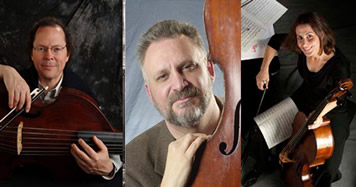Just when you think that well into their 33rd concert season the Mallarmé Chamber Players had exhausted the well of unique and educational programs, along comes a fascinating concert the likes of which have not been experienced in this area. The Kenan Music Building‘s rehearsal room on the campus of the University of North Carolina at Chapel Hill was packed to the brim on a picture perfect fall afternoon, as a rarely heard instrument took center stage. The baryton, its history, its modern-day virtuosi, and a celebration of the life of its most influential teacher and pedagogue were all on hand.
For those of us who regularly listen to a dwindling selection of classical music radio stations, we have most likely heard a broadcast of a Haydn baryton trio. Perhaps after looking up this alien-named instrument (no, it’s not an alternate spelling of “baritone”), we had a vague conception of the baryton. But, until this concert, few have had a chance to see and hear not one, but two of these instruments playing in a wide variety of ensembles. Add to this the all-star cast of musicians and an esteemed lecturer, and you have a nearly historic concert.
Serving as emcee of sorts, was UNC’s own Brent Wissick, Professor of Music at UNC Chapel Hill and an internationally known master of early music practice and performer of bowed instruments. Wissick and Mallarmé gathered twelve musicians and speakers to present the baryton in performance in its correct musical and historical setting. The concert was also presented to honor John Hsu, Professor Emeritus of Cornell University where for 50 years he taught cello, gamba, music history and was a pioneer in the early years of the Historically Informed Practice (HIP) movement. Several of the musicians on hand, including Wissick, studied with Hsu and consider him a significant influence on their musical education and growth.
So what is the baryton? Descriptions cannot do it justice, but it is a variant of a viol with the added feature/difficulty of being able to pluck from nine steel strings either separately or while also bowing and fingering on six or seven gut strings. Aside from its musical significance, barytons are a marvel of complicated instrument construction usually topped off with a beautifully carved head scroll.
There is no precedent either before or since the apex of the baryton’s popularity of the nearly complete monopoly by three characters in music in one genre: the Baryton itself, the composer Franz Joseph Haydn, and his patron, Prince Nicholas Esterhazy. Haydn composed over 170 works that include the baryton, and compositions by any other composer seem to have been thrown on the dust heap of music history. So, it is no surprise that all eight works performed this afternoon (yes – quite a long program) were by Haydn.
After a delay to arrange seating and accommodate the overflow audience, the program began with one of the nearly 130 of the most popular vehicles of this instrument: the trio for baryton, cello and viola. This was number 48 and featured Wissick on the baryton, Mallarmé Artistic Director and violist Suzanne Rousso, and cellist Stephanie Vial. All instruments played in this concert were historically accurate, and the musicians employed HIP performance practices.
If you like one baryton, then you could double the love for a baryton duo with Wissick and special guest Kenneth Slowik, a distinguished and wildly prolific champion of the baryton as well as early music performance practice. This gave us an opportunity to hear two of these instruments together displaying the versatility and unique sound that makes one wonder why even in the HIP world the baryton is still a relative rarity.
Next came a lecture on the Haydn-Esterhazy-baryton trinity by James Webster, Professor of Music at Cornell. It’s always nice to get the academic viewpoint adjacent to hearing the real thing, and Webster’s remarks provided some insight into the sounds.
Robbie Link was added to the mix on the violone, basically a bass viol. We heard a very charming five-movement cassation, a term used in many Haydn works denoting a serenade or divertimento. These were brief movements that exuded joy and a carefree life (if perhaps you were an Austrian nobleman).
There was then an unusual break to hear a recording by Hsu playing the baryton and using the simultaneous bowing and plucking. This was an astounding and ear-opening experience especially since it did not sound as if the live baryton players were using much, if any, of this technique.
Of the more than 120 baryton trios written by Haydn, it is Trio No. 97 that is generally acknowledged to be his finest. This seven-movement work ranks with his greatest string quartets and was perhaps, compositionally, the highlight of the afternoon. Rousso’s solos in the first Menuet were especially captivating and brilliantly played.
The finale was an Octet played by eleven musicians! Huh? The explanation is that flute and oboe replaced the dying out baryton, but since there was a baryton playing, I don’t quite get it. With Nicholas DiEugenio and Leah Peroutka, violins, Rebecca Troxler, flute, William Thauer, oboe, and Celeste Holler and Rick Seraphinoff, horns added to the previously named performers, we had a nice chamber-sized orchestra playing Haydn’s Octet in D. This is a fully mature work that belongs in the “best of” list of Haydn’s chamber works. Each instrument had its chance to shine, and it was a glorious ending to one of the most enlightening and enjoyable musical afternoons I can recall in a very long time.











